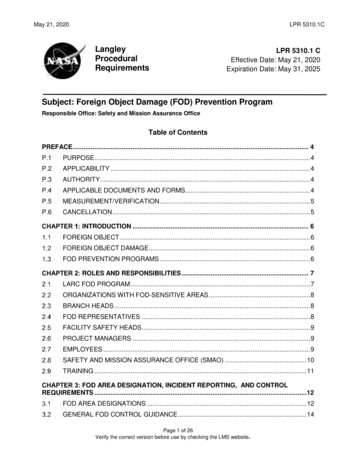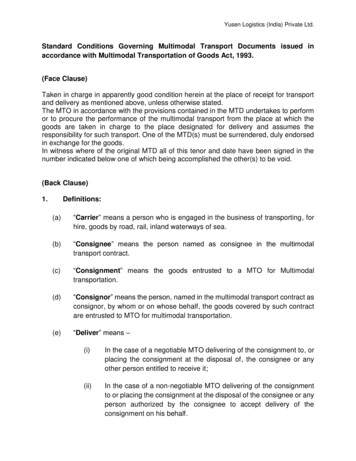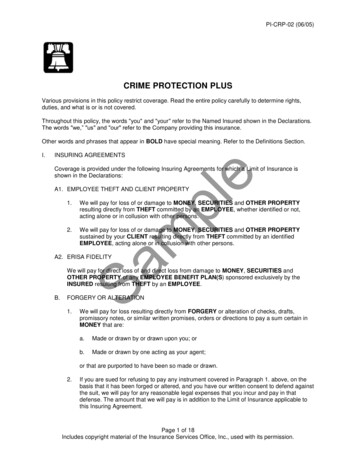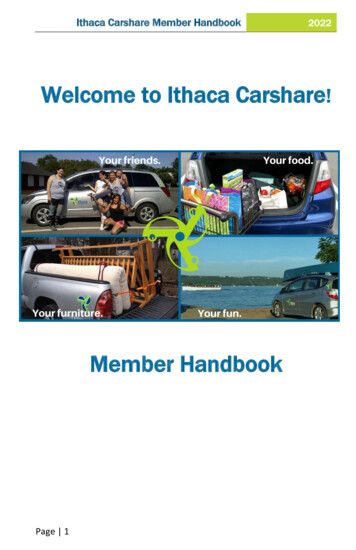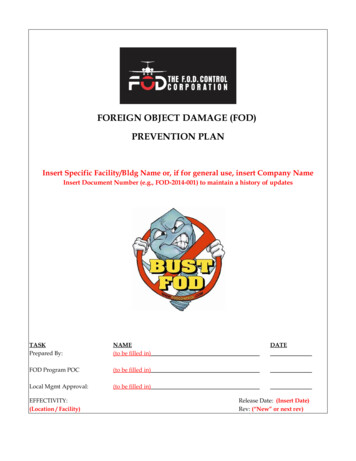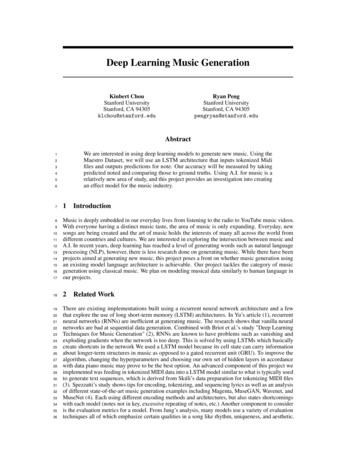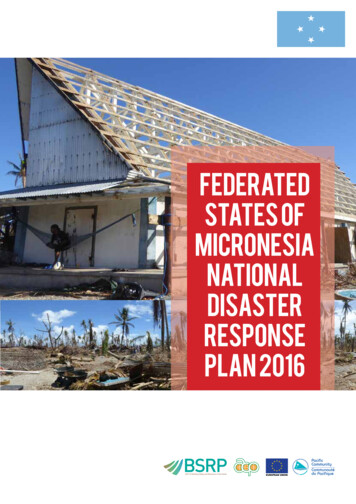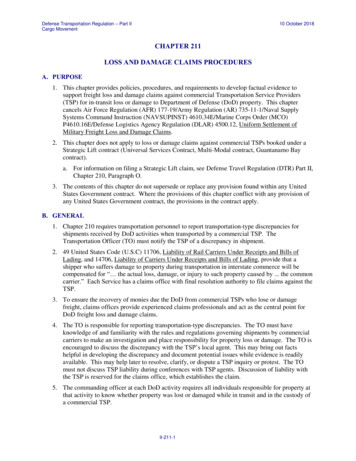
Transcription
Defense Transportation Regulation – Part IICargo Movement1 February 2022CHAPTER 209LOSS AND DAMAGE PREVENTION AND ASTRAY FREIGHT PROCEDURESA. GENERALThis chapter provides procedures and requirements applicable to shippers, receivers, TransportationService Providers (TSP) providing commercial transportation and related services to the Departmentof Defense (DoD) and other authorized users of the Defense Transportation System (DTS). Itprovides guidance for proper shipping and receiving of DoD Government cargo in order to preventloss and damage and for documenting astray freight under the DoD Government Cargo RecoveryEffort (GOCARE) program.B. SHIPPING AND RECEIVING RESPONSIBILITIES1. The Transportation Officer (TO) or receiving facility will:a. Implement effective shipping and receiving procedures to minimize cargo loss and damage(see Figure 209-1, Shipping Checklist, and Figure 209-2, Receiving Checklist).b. Document and resolve transportation discrepancies, to include misdirected and damagedcargo, in accordance with (IAW) Chapter 210 and Chapter 213.c. Submit changes to the Transportation Facilities Guide (TFG) using the TransportationEnhance Access Management Services (TEAMS) Global Freight Management (GFM)website at https://eta-teams.transport.mil/teams/login.d. Conduct or arrange for comprehensive training of all personnel involved with packaging,documentation, and receiving.C. SHIPPING PROCEDURES1. Outbound freight personnel will:a. Ensure freight is packaged to withstand the ordinary transportation hazards based on thetransportation mode selected.b. Ensure shipping documentation and labeling is complete and accurate. Package labels andshipping labels will be prepared IAW Chapter 208 and MIL-STD-129. In-transit datatransactions and radio frequency identification (RFID) marking will be IAW Chapter 203.c. Provide a legible copy of the bill of lading (BL) or other shipping papers (including Reportsof Shipment [see Figure 205-13]) to the consignee(s). The primary delivery method shouldbe via system-to-system Electronic Data Interchange (EDI)/Extensible Markup Language(XML) data exchange. Fax and e-mail may be used if system-to-system data exchange is notavailable. See Appendix E for Foreign Military Sales shipments.d. Consider increasing the declared valuation and pay additional minimal costs if a shipmentrequires additional coverage because of its sensitivity, scarcity, historical value, or otherunusual characteristics. DoD Government freight shipments moved by commercial carriersare subject to varying degrees of valuation, depending on the mode of shipment, commoditycode used, or the terms of carriage. Shippers will consult and follow Service/Agency specificguidance to determine when an increased, declared value is appropriate.II-209-1
Defense Transportation Regulation – Part IICargo Movement1 February 2022D. DELIVERY PROCEDURES1. Designated receiving personnel will:a. Accept all DoD shipments. The TO will not refuse delivery of DoD freight at their facility.Accept the load and place the freight in a designated area until a determination can be madeas to how to handle the disposition of the freight. There may be receiving exceptions forexpress TSP and United States Postal Service.b. Receive copies of the shipping documents, BL, from the shipping office and establish a duein suspense file. If the cargo is not received, contact the origin shipper and or carrier. Initiatetracer and claim action.c. Count all boxes, containers, and/or pieces received in each shipment.d. Examine each item unloaded from the carrier’s conveyance. When a box or shipment showsevidence of damage or pilferage, call it to carrier’s attention and segregate these items fromother unloaded items to ensure that a proper record is made.e. Keep a record of piece count and condition of material when shipment is in-checked. Thisrecord will show shipment identification, carrier equipment number, time, date, seal number,condition of seals, and checker’s name. Consignee’s copy of the BL, a tally sheet, or otherapproved forms will be used IAW Service specific instructions/guidelines.f.Record any overage, shortage, or damage.(1) When materiel received is in excess of the quantity shown on the BL, annotate carrierdelivery receipt and report all overages and reconciliation IAW Chapter 210.(2) Annotate original and consignee’s copy of carrier’s delivery receipt with specificidentification of missing or damaged items. Sign and date all copies of the deliveryreceipt.(3) Ensure the carrier’s representative signs all copies of delivery receipt.(4) Do not annotate the carrier’s delivery receipt with comments such as “Subject to countand inspection.”g. Take photographs (before unloading, if possible) when damage exists or other conditionsindicate loss or damage may exist.h. If damage is noted after the carrier’s representative departs, immediately contact carrier’snearest office to report the damage and request a shipment inspection.i.Give the carrier up to 7 calendar days to inspect the shipment. If the carrier waivesinspection, make a record of the waiver; include the name of carrier representative and thedate and time the carrier waived shipment inspection.j.Avoid opening damaged freight until a carrier representative is present.(1) If prompt unpacking reduces damage to a shipment, the shipment may be unpacked.(2) Damaged freight creates a hazardous situation or presents a health risk. If this occurs,unpacking must occur immediately.k. Obtain a copy of the carrier’s inspection report to include in the Transportation DiscrepancyReport (TDR) package. If the carrier assumes responsibility, obtain a certified statementattesting to this assumption.II-209-2
Defense Transportation Regulation – Part IICargo Movementl.1 February 2022Do not release any TOP SECRET, SECRET, CONFIDENTIAL, sensitive, and technicalsupplies or equipment to a carrier for repair or salvage. Contact the Item Manager (IM) fordisposition instructions. (See Chapter 210.)m. Avoid discussing liability with the carrier.n. Accept delivery of shipments damaged during transportation regardless of who has damagerisk responsibility and annotate the carrier delivery receipt.E. GOCARE PROGRAM1. This program provides the DoD with a method to recover lost and astray freight (material lost inshipment) and return it to the DoD. The success of the DoD GOCARE program depends uponmaintaining a strong, cooperative link between the government and the TSP industry. The DoDGOCARE program is intended to be non-adversarial. While the government has the obligationand right to independently verify the existence of astray freight, it also recognizes that the TSPindustry is law-abiding, ethical, and conscientious.2. Services’ and DoD agencies’ transportation personnel should ensure their leadership are aware ofthe DoD GOCARE program and the program’s positive results.3. Additional information on the DoD GOCARE program can be found in the GOCARE guidelines.Copies may be obtained from:HQ Military Surface Deployment and Distribution CommandAttn: AMSSD-OPM-M1 Soldier Way,Building 1900 West,Scott AFB, IL 62225The guidelines are also available at .4. The continued success and improvement of the program depends upon mutual cooperationbetween TSP and the government. Participation as a Chairperson (CP) or Committee Member(CM) may be an additional duty. Supervisors should be made aware of this and ensure theGOCARE participants are allowed the necessary time and means to perform these duties in amanner beneficial to the DoD. The GOCARE CM and CP should receive appropriate recognitionfor their accomplishments. The requirements are suggested to be included in the CM and CPPosition Descriptions.F. GOCARE RESPONSIBILITIES1. SDDC provides program management for the DoD GOCARE program. Program management isexercised through SDDC operations. They will:a. Provide the primary link between the government and the TSP industry.b. Develop and administer the DoD GOCARE program.c. Evaluate the effectiveness of the GOCARE committees.d. Coordinate changes to the GOCARE Committee Handbook.e. Provide training to GOCARE CMs.f.Update and maintain DoD GOCARE publications, guidelines, and policy on the SDDCwebsite at .II-209-3
Defense Transportation Regulation – Part IICargo Movement1 February 2022g. Recommend changes to the DoD GOCARE program, and provide the CP with timelycorrespondence detailing changes to the program.h. Review and analyze all GOCARE reports, identify trends or weaknesses, and recommendcorrective actions as necessary.i.Provide program oversight through periodic visits to GOCARE CM locations and TSPterminals. Prepare and retain reports of each visit as part of the GOCARE historicaldocuments.j.Host annual meetings with the CPs or their representatives. Prepare minutes or a summary ofeach meeting, post the minutes, distribute them to CPs, and retain them as part of the SDDChistorical documents.k. Assist TSPs in locating CMs in their geographical areas.2. The Agency CPs are responsible for monitoring the execution of the DoD GOCARE programwithin their respective agencies. The Agency CP will:a. Provide an updated listing of all CMs to SDDC semi-annually.b. Provide all CMs information on training opportunities related to the DoD GOCARE program.c. Monitor the Agency GOCARE program, ensure GOCARE geographical coverage, and reportagency GOCARE activity in quarterly report.d. Provide reporting procedure guidance to CMs. Monitor CM reporting and provide assistanceand training as necessary.e. Provide a quarterly report to AMSSD-OPM-M at usarmy.scott.sddc.mbx.gocarriers@army.mil, IAW Table 209-1. A negative reply is required.Reports will include:(1) Number of TSP facilities visited/called by each CM(2) Specific TSP name and location visited/called(3) Number of astray shipments located and number of shipments known to be DefenseTransportation Coordination (DTC)(4) Actual or estimated value of shipments located(5) Manpower hours spent(6) Issues identified and associated corrective actions.f.Utilize the SDDC GOCARE website at to obtain DoD GOCARE program publications, guidelines, and policy.g. Ensure all CMs incorporate point of contact (POC) information in the TFG for SDDC andTSPs to utilize with astray freight issues.h. Attend or ensure representation at the annual CP meeting held by SDDC.i.Conduct periodic meetings with all assigned CMs, either in person or via telecom (meetingswill be held at least semiannually). Prepare minutes or a summary of each meeting and retainas part of the committee's historical documents.j.Encourage CMs to attend loss and damage mini-freight workshops hosted by TSPs held intheir geographical area.II-209-4
Defense Transportation Regulation – Part IICargo Movement1 February 2022k. Recommend the inclusion of adequate funding in the annual installation/activity budgetplanning process to permit holding semiannual committee meetings.l.Address problems and requests for assistance from SDDC as necessary.3. The installation TO or other cognizant authority will appoint GOCARE CMs for their installation.The GOCARE CM will:a. Serve as part of a GOCARE committee, responsible for covering a specific geographical area.b. Serve as a POC between TSP representatives and the DoD for all astray/frustrated cargoproblems or questions. Establish a rapport with all local air, motor, rail, and water TSPterminal managers to encourage each TSP's full participation in GOCARE.c. Incorporate CM contact information into the TFG for use by TSPs and SDDC to contact theCM with astray freight issues.d. Ensure the delivery and posting of an approved GOCARE poster in each assigned TSPterminal or warehouse and request additional posters from SDDC.e. Contact assigned/designated locations on at least a quarterly basis. Visits to TSP facilities bya DoD GOCARE representative will be coordinated and scheduled for a mutually convenienttime. Only over, short, and damaged (OS&D) freight will be inspected in association withthe GOCARE visit.f.Upon notification that a TSP has frustrated or astray DoD property, CMs will verify theownership, provide a receipt to the terminal manager, and make arrangements to forward theshipment to a DoD-approved location.g. Ensure TSPs obtain the appropriate documentation to secure payment for all servicesrendered.NOTE: Utilizing Transportation Account Codes (TAC) for astray freight will vary. Many TSPswill deliver as part of the original cost. Some will utilize a TAC provided by theService/Agency. Payment will be dealt with on a case-by-case basis.h. CMs will document all calls and visits for the record, and report to the CP.i.Identify astray freight and contact the appropriate TSP, consignee, consignor, item manager,or other personnel to obtain documentation and disposition instructions for freight shipments.j.Arrange with TSP or local TO for delivery of any recovered property; develop appropriatefreight forwarding procedures IAW the DoD GOCARE program guidelines.k. Utilize the SDDC GOCARE website at to obtain DoD GOCARE program publications, guidelines, and policy.l.Complete a DD Form 361, Transportation Discrepancy Report (TDR), Figure 209-3, IAWDoD 4500.9-R, Defense Transportation Regulation, Part II, Cargo Movement, Chapter 209and Chapter 210, to record all available information for the astray freight. The DiscrepancyIdentification System (DIS), located under the Global Freight Management (GFM)/ETAdatabase, will be used to prepare astray freight TDRs. Ensure the appropriate TSP is includedas an addressee when processing the TDR in DIS. Keep one copy in the CM file.m. Attend CM meetings hosted by CP as well as attending other transportation and trafficmanagement meetings, seminars, and training classes.n. Submit local travel funding requests for inclusion in the annual installation/activity budgetplanning process to permit performance of required duties.II-209-5
Defense Transportation Regulation – Part IICargo Movement1 February 2022G. PROCEDURES FOR HANDLING ASTRAY FREIGHT1. Disposition of Identifiable Freight. If astray freight is identified clearly as belonging to the DoD,and shipper markings are available, the CM will contact the shipper to determine the identity ofthe consignee, the destination, and the BL reference.a. The CM may contact the shipper from the TSP’s facility or may wait until returning to his orher office.b. The freight may be left with the TSP until the CM can provide forwarding instructions.2. Disposition of Unidentifiable Freight. If the freight is identified as belonging to the DoD butthere are no markings or the markings are conflicting:a. The freight may be opened and inspected in the presence of an authorized TSP representativeto determine the existence of any packing lists or other evidence of property identification.b. If neither the shipper nor consignee can be identified, contact the IM for dispositioninstructions. If the IM cannot be identified, contact SDDC for assistance.c. The TSP will be instructed to deliver the freight to the CM’s facility or an approvedgovernment destination, pending disposition.d. Freight that is not identified as belonging to DoD and bearing no marking will remain in theTSP’s possession.H. DFTS SUPPORT OF DOD GOCARE PROGRAM1. The DFTS COORDINATOR Astray Freight POC will:a. Assist in identifying astray freight and, when found, report astray freight to SDDC Operations(the Office of Primary Responsibility of this guideline).b. Work with Government personnel and the sub-contracted TSP/TSP to resolve astray freightissues.2. When a sub-contracted TSP discovers astray freight in its terminal or warehouse:a. The TSP will report astray freight to the local GOCARE CM and to DFTS CoordinatorAstray Freight POC.b. If the local representative is unavailable or not known, the TSP will contact the SDDCGOCARE PM at usarmy.scott.sddc.mbx.go-carriers@army.mil for assistance.c. Pending final disposition, the TSP may turn the astray shipment over to the nearest DoDtransportation office.3. The CM at DFTS sites will:a. Follow all requirements outlined in this guidelineb. Coordinate with TSP and the DFTS Coordinator’s Astray Freight POC to resolve astrayfreight issuesc. Annotate on the quarterly reports the number of known DFTS shipments that were locatedduring the reporting periodd. If necessary, submit a claim through DFTS Coordinator’s Web-based reporting tool located athttps://tms.crowley.com/web/login.II-209-6
Defense Transportation Regulation – Part IICargo Movement1 February 2022SHIPPING CHECKLIST Is the shipment routed IAW the priority?Using Service specific instructions/guidelines, was increasing the valuation on the BLconsidered?Is the freight properly prepared for shipment to withstand the ordinary hazards oftransportation for the mode selected?When reusable shipping containers are used, are all previous markings completelyobliterated?Are the shipping documents matched against the shipping labels to ensure correct andaccurate shipping information?Is the BL accomplished completely and accurately IAW all current regulations andinstructions?Is the transportation company hauling the freight contacted and given sufficient time to pickup the shipment?When the transportation company picking up the freight arrives, is the date and time recordedon the shipping records?Before the shipment is loaded on the carrier’s equipment, do the shipping clerk and the driverjointly check the equipment?As the freight is loaded, is it counted and matched against the BL?Does the carrier’s driver sign and date the BL to include the number of pieces in theshipment?Is the carrier driver’s signature clear and legible?Does the carrier's driver receive the correct copies of the BL?Is the shipping information entered on copies of the shipping document?Are the consignee’s copies of the BL and supporting documents sent to destination to assurearrival in advance of the shipment?Figure 209-1. Shipping ChecklistII-209-7
Defense Transportation Regulation – Part IICargo Movement1 February 2022RECEIVING CHECKLIST Have all designated receiving personnel been trained in loss and damage preventionprocedures and techniques?Was the carrier’s delivery receipt annotated with the date and time the carrier arrived forunloading, the date and time the carrier departed, and the number of pieces unloaded?Was the carrier’s vehicle checked for seal integrity prior to opening the trailer; were sealnumbers written down on the carrier's delivery receipt?Were the labels on all containers checked to ensure the property belongs to your activity; didthe labels match the pieces, TCN, and/or weight as shown on the carrier’s delivery receipt orthe BL (commercial or government)?Was each off loaded container checked for possible damage; was damaged propertyimmediately brought to the attention of the carrier’s driver?Was the carrier’s delivery receipt annotated with the number of pieces damaged or short,along with the TCN number and type of damage (e.g., bent, crushed, leaking)?Did both the carrier’s driver and the inchecker acknowledge the shortage or damage notationon the carrier’s delivery receipt?Were photographs taken of damaged property?Was the carrier’s representative called and a request made for an inspection of damagedproperty; was a record made of the name of the person contacted, date, and time of theirresponse?When a carrier chooses not to inspect damaged property, did technically qualified personnelat your activity perform an inspection?On “free astray” or “dead head” bills, were the TCN, consignor, pieces, weight, and any othermarkings identifying the property written on the carrier’s delivery receipt?When concealed damage was reported to the inchecker, did they immediately report thedamage to the carrier’s representative, obtain statements from personnel who found thedamage, and report this information to the transportation OS&D clerk?Were all discrepancies reported to the transportation OS&D clerk immediately upondiscovery?Is there a program in place to ensure all activities other than Transportation know the rules foraccepting freight and annotating the carrier’s delivery receipt?Figure 209-2. Receiving ChecklistII-209-8
Defense Transportation Regulation – Part IICargo Movement1 February 2022Figure 209-3. DD Form 361, Transportation Discrepancy Report (TDR)(Source Document for Claims)II-209-9
Defense Transportation Regulation – Part IICargo Movement1 February 2022Figure 209-3. DD Form 361, Transportation Discrepancy Report (TDR)(Source Document for Claims) (Cont’d)II-209-10
Defense Transportation Regulation – Part IICargo Movement1 February 2022Table 209-1. Astray Freight Quarterly Reporting PeriodQuarterReporting PeriodReport Due Date1stOctober 1 thru December 3121 January2ndJanuary 1 thru March 3121 April3rdApril 1 thru June 3021 July4thJuly 1 thru September 3021 OctoberII-209-11
Defense Transportation Regulation – Part IICargo Movement1 February 2022THIS PAGE INTENTIONALLY LEFT BLANKII-209-12
j. Avoid opening damaged freight until a carrier representative is present. (1) If prompt unpacking reduces damage to a shipment, the shipment may be unpacked. (2) Damaged freight creates a hazardous situation or presents a health risk. If this occurs, unpacking must occur immediately. k.

